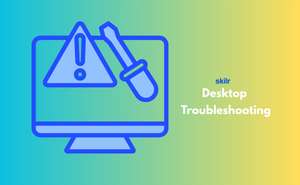👇 CELEBRATE CLOUD SECURITY DAY 👇
00
HOURS
00
MINUTES
00
SECONDS

Desktop troubleshooting involves identifying, diagnosing, and resolving issues that occur on a computer system. It encompasses a range of problems, including hardware malfunctions, software glitches, connectivity issues, and performance problems. Troubleshooting often begins with gathering information about the problem, such as error messages or recent changes to the system. Then, various troubleshooting techniques are used to isolate the issue, such as checking connections, running diagnostic tests, and analyzing system logs. Once the problem is identified, appropriate solutions are implemented, which may include updating drivers, reinstalling software, or replacing faulty hardware components. Effective desktop troubleshooting requires a systematic approach, technical knowledge, and problem-solving skills to ensure the smooth operation of the computer system.
Why is Desktop Troubleshooting important?
Who should take the Desktop Troubleshooting Exam?
Desktop Troubleshooting Certification Course Outline
Desktop Hardware
Operating Systems
Networking
Software
Security
Data Backup and Recovery
Troubleshooting Methodology
Customer Service
Remote Desktop Support
Hardware and Software Upgrades
Troubleshooting Tools
Performance Optimization
Industry-endorsed certificates to strengthen your career profile.
Start learning immediately with digital materials, no delays.
Practice until you’re fully confident, at no additional charge.
Study anytime, anywhere, on laptop, tablet, or smartphone.
Courses and practice exams developed by qualified professionals.
Support available round the clock whenever you need help.
Easy-to-follow content with practice exams and assessments.
Join a global community of professionals advancing their skills.
(Based on 158 reviews)
Troubleshooting is generally done on hardware equipment installed within a computer, server, laptop or related device.
Students, professionals engaging in hardware and repair activities, technical support professionals, and IT Support professionals.